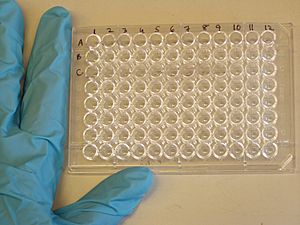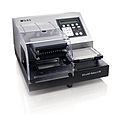Microtiter plate facts for kids
A microtiter plate (also called a microplate) is a flat plate with many tiny "wells." Think of these wells as very small test tubes, all lined up together. Scientists and doctors use these plates to do many experiments at once, using only tiny amounts of liquids.
What is a Microplate?
Microplates are mostly used in science labs and pharmacies. They help researchers test many different things quickly. A microplate can have various numbers of wells, like 6, 24, 96, 384, or even 1536. These wells are always arranged in neat rows and columns.
Some special microplates, used in big factories, can have even more wells, like 3456 or 9600! This helps them test a huge number of samples very fast. Each well on a microplate is designed to hold only a tiny drop of liquid.
How Microplates Were Invented
The very first microplate was created in 1951 by a Hungarian scientist named Dr. G. Takatsky. His plate had 72 wells, arranged in 6 rows of 12.
Microplates started to become very popular in the late 1950s. An American man named John Liner made an improved version that was even better. By 1990, more than 15 different companies were making microplates for labs all over the world.
In 1996, a group called the Society for Biomolecular Screening (SBS) decided that microplates should all be made to certain standards. This meant that by 2003, all microplates had to have a specific diameter (how wide they are) and depth (how deep the wells are). This made it easier for different labs to use the same equipment with different plates.
Today, special machines called plate readers are used with microplates. These machines can detect small biological, chemical, or physical changes in the liquids inside the wells. This helps scientists learn a lot about what's happening in their experiments.
Related pages
Images for kids
See also
 In Spanish: Placa microtituladora para niños
In Spanish: Placa microtituladora para niños





